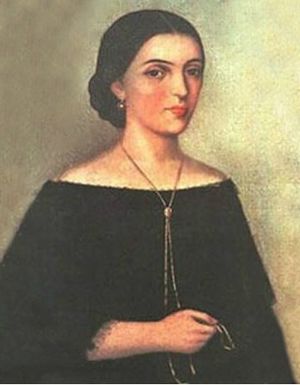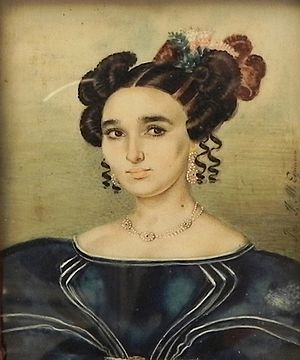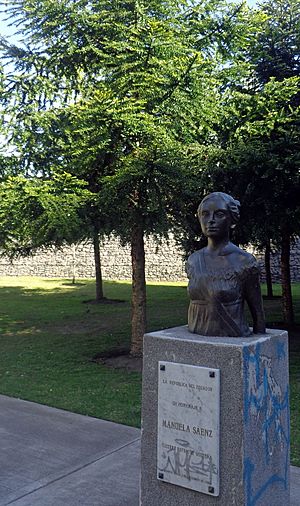Manuela Sáenz facts for kids
Quick facts for kids
Manuela Sáenz
|
|
|---|---|

Libertadora del Libertador
wearing the Order of the Sun medal |
|
| 1st First Lady of Colombia | |
| In office 17 June 1822 – 4 May 1830 |
|
| President | Simón Bolívar |
| Preceded by | Office established |
| Succeeded by | Juana Jurado y Bertendona |
| 6th First Lady of Peru | |
| In office 10 February 1824 – 28 January 1827 |
|
| President | Simón Bolívar |
| Preceded by | Mariana Carcelén |
| Succeeded by | Francisca Cernadas |
| 1st First Lady of Bolivia | |
| In office 12 August – 29 December 1825 |
|
| President | Simón Bolívar |
| Preceded by | Office established |
| Succeeded by | Mariana Carcelén |
| Personal details | |
| Born |
Manuela Sáenz de Vergara y Aizpuru
27 December 1797 Quito, Viceroyalty of New Granada |
| Died | 28 September 1856 (aged 58) Paita, Peru |
| Spouse | James Thorne (married 1817 – estranged 1822) |
| Domestic partner | Simón Bolívar (1822–1830) |
| Occupation | Revolutionary and spy |
| Signature | |
Manuela Sáenz (born December 27, 1797 – died November 23, 1856) was an important revolutionary hero from Ecuador. She helped South America gain independence from Spain. Manuela gathered information, shared important papers, and spoke up for women's rights.
She received the Order of the Sun award. This honor recognized her brave actions in the fight for freedom. She was called "Caballeresa del Sol" or 'Dame of the Sun'.
In 1817, Manuela married a wealthy English doctor. She became a well-known person in Lima, Peru. This allowed her to get involved in political and military matters. She actively supported the revolution.
In 1822, she left her husband. Soon after, she began an eight-year partnership with Simón Bolívar. This lasted until his death in 1830. In 1828, she saved Bolívar from an attack. She helped him escape danger. Because of this, Bolívar called her "Libertadora del libertador" (meaning "liberator of the liberator").
For many years after her death, Manuela's role was not fully recognized. But now, she is seen as a symbol of women's strength in the 19th-century wars for independence.
Contents
Her Early Life
Manuela was born in Quito. Her mother was Maria Joaquina Aizpuru from Ecuador. Her father was a Spanish nobleman named Simón Sáenz de Vergara y Yedra.
Her father made sure young "Manuelita" went to school. She studied at the Convent of Santa Catalina. There, she learned to read and write. She stayed in touch with the nuns for much of her life. She left the convent when she was seventeen.
Joining the Revolution
Manuela lived with her father for some years. In 1817, she married James Thorne, a rich English doctor. They moved to Lima, Peru, in 1819. There, she lived like an important person. She held social gatherings at her home. Political leaders and military officers were often guests.
These guests shared secret military information with her. In 1819, Simón Bolívar successfully freed New Granada. Manuela Sáenz then became very active in the fight against Spanish rule. She joined a secret group against the viceroy of Perú, José de la Serna e Hinojosa, in 1820.
Manuela, her friend Rosa Campuzano, and other women helped the cause. They tried to get colonial soldiers to join the anti-Spanish army. They focused on the Numancia regiment in Lima. This plan worked well. Many soldiers, including Manuela's half-brother, joined the army of José de San Martín.
People saw Manuela as a hero. She was known for her strong love for her country. This patriotism showed in her support for the local uprising against Spanish control.
After Peru became independent in 1821, Jose De San Martin honored Manuela Saenz. He gave her the highest award in Peru, the Order of the Sun. In her early days, she held secret meetings. She passed on information as a spy. Manuela Saenz also helped with talks involving the Numancia battalion.
Her Partnership with Simón Bolívar
In 1822, Sáenz left her husband. She traveled to Quito. At a ball there, she met Simón Bolívar. They soon became close. They wrote love letters to each other. She visited him as he moved from country to country. Bolívar sometimes called her la amable loca, which means "the dear madwoman."
Manuela helped the revolution in many ways. She gathered information and shared important papers. She also spoke out for women's rights. She was one of the most important women in the wars for independence. She received the Order of the Sun award.
In public, she often wore a colonel's uniform. Her two servants, Jonatás and Nathán, also wore soldier uniforms. In 1825 and 1826, she lived with Bolívar near Lima. But Bolívar had to leave as the war continued.
Manuela was a key supporter of Bolívar. In January 1827, some soldiers in Lima rebelled. They arrested officers and took over parts of the city. They wanted better food and pay. Manuela stayed in Lima to help Bolívar's affairs. She tried to stop the rebellion.
She appeared in full uniform and spoke to the soldiers. She asked them to stay loyal to Bolívar. She also tried to pay soldiers to support Bolívar. She was captured by the new Peruvian government and put in a convent. She protested her treatment. She was released in March and forced to leave Peru in April. Because of her actions, people started calling her the Libertadora. Manuela then followed Bolívar to Bogotá.
On September 25, 1828, some officers tried to harm Bolívar. Manuela woke up when she heard fighting. Bolívar wanted to check, but Sáenz convinced him to escape through a window. She then faced the attackers. She told them Bolívar was still in the building. She led them to different rooms, pretending to be lost. She even stopped to help a wounded person. Eventually, the attackers became impatient and hit her before leaving. Her actions led Bolívar to call her "Libertadora del Libertador."
After this event, Manuela helped Bolívar understand which army officers were loyal. She tried to help him keep control of Gran Colombia, which was falling apart.
Bolívar left Bogotá in 1830. He died in Santa Marta from tuberculosis while traveling. He had not made any plans for Manuela. Before he died, Bolívar asked his helper, General Daniel Florencio O'Leary, to burn his writings. O'Leary did not obey. So, Bolívar's writings, letters, and speeches survived. These papers give historians much information about Bolívar's ideas and his life, including his long relationship with Manuela Sáenz. Before her own death in 1856, Sáenz gave O'Leary her own letters from Bolívar.
After Bolívar's death, Francisco de Paula Santander came back to power. He sent Manuela away. She went to Jamaica for the first years of her exile. She remained active in politics until the mid-1840s.
Years in Exile and Death
In 1835, Manuela tried to return to Ecuador. But the Ecuadorian president, Vicente Rocafuerte, would not let her. He said that women caused too much trouble in these countries. She then went to northern Peru. She lived in the small town of Paita.
She became poor. For the next twenty-five years, Manuela sold tobacco. She also translated letters for North American whale hunters. While there, she met the American author Herman Melville and the revolutionary Giuseppe Garibaldi.
Manuela Sáenz and other women continued to work against Spanish rule. She started "The Society of Patriotic Ladies." Its motto was “To the patriotism of the most sensitive."
Manuela died in Paita on November 23, 1856. She passed away during a diphtheria outbreak. Her body was buried in a shared grave. Her belongings were burned. The items that survived, like personal letters, later helped tell the story of both her and Simon Bolívar.
Her Impact on Women's Roles
During Manuela's time, women were expected to stay at home. Politics and war were seen as men's work. But she found ways to take part in these male-dominated areas. She also used her social skills to have influence.
She did not let traditional ideas about women stop her. She was brave and took part in military actions.
Manuela is often seen as a woman who broke away from old rules. She believed strongly in freedom and independence.
When she was in exile, she talked about the importance of friendship. She used this idea to show how women could have influence in politics. Her work argued against keeping women out of political life. She connected friendship with women supporting each other.
Friendship became a way for independent women to have more influence. Sáenz believed that friendship would bring stability. She changed how people thought about women's roles by encouraging friendship among women.
Recognition and Reburial
On July 5, 2010, Manuela Sáenz was given a full state burial in Venezuela. Since she was buried in a mass grave, there were no official remains of her. Instead, "symbolic remains" were used. These were made of soil from the mass grave where she was buried. This soil was taken through Peru, Ecuador, and Colombia to Venezuela. These symbolic remains were placed in the National Pantheon of Venezuela. Bolívar's remains are also there.
On May 25, 2007, the Ecuadorian government gave Manuela Saenz the rank of General as a symbol of her importance.
Manuela Sáenz Museum
The Museo Manuela Sáenz is a museum in Old Town, Quito. It holds personal items from both Sáenz and Bolívar. Its goal is to protect the memories of Manuela Saenz. The museum is located at Junin 709 y Montufar, Centro Histórico, Quito. You can enter the museum for free if you buy one of the books about Manuela's life. Inside, you can see letters, stamps, and paintings.
Movies and Opera About Her
- Manuela Sáenz, a movie directed by Diego Rísquez (2000).
- Manuela y Bolívar, an opera by Diego Luzuriaga (2006).
- Bolívar, a Netflix Original Series (2019).
Images for kids
See also
 In Spanish: Manuela Sáenz para niños
In Spanish: Manuela Sáenz para niños




